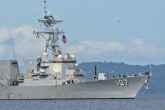April 21, 2017
Below Glideslope: The MQ-25 Stingray Appears to be Heading for a Ramp Strike
Even as reports surface of American supercarriers and their embarked air-wings hurriedly steaming towards the Korean peninsula, the saga of the Navy’s carrier based unmanned aircraft program seems to have taken yet another turn for the worse. Instead of adhering to direction by both the Chief of Naval Operations (CNO) and the Deputy Secretary of Defense to maximize the strike range of the carrier air wing it appears that naval aviation leadership is placing its finger on the MQ-25 design scale and prioritizing unrefueled endurance for the intelligence/surveillance/reconnaissance (ISR) mission at the expense of great fuel offload for long-range mission tanking.
During recent discussions naval aviation leaders stated that the threshold requirements for the as yet un-designed MQ-25 would include the ability to remain airborne for 12 hours in order to perform overnight ISR missions while the carrier deck is shut down. This requirement for MQ-25 to “bridge the night” is a “cut and paste” from the Unmanned Carrier Launched Surveillance and Strike (UCLASS) program requirement, which was canceled after a review of Joint ISR capabilities concluded that a carrier-based ISR aircraft wasn’t necessary. The problem for MQ-25? Designing an aircraft to fly 12 hoursunrefueled negatively impacts its ability to carry large fuel (or other) payloads over long distances. During UCLASS, the ISR endurance requirement came at the expense of internal weapons payload. On MQ-25, the 12-hour requirement applies a “tax” on the aircraft’s long-range refueling capacity.
Read the full article at The National Interest.
More from CNAS
-
Who Will Lead on Military AI, the Government or Industry?
The military is going to use artificial intelligence. But while planners in the government may have an idea of the best way forward, can they truly lead, or will industry stee...
By Josh Wallin
-
What Trump Really Wants with Venezuela
The Trump administration says it’s targeting narco-traffickers. But critics at home and abroad have decried the attacks and challenged their legal basis. Meanwhile, President ...
By Becca Wasser
-
Defense / Technology & National Security
What to Expect from Military AI in 2030As the US military races to harness artificial intelligence, experts say the biggest AI breakthroughs may not come from “killer robots” or autonomous war machines, but from al...
By Josh Wallin
-
Defense / Indo-Pacific Security / Technology & National Security
To Compete with China on Military AI, U.S. Should Set the StandardsThe United States has an opportunity to lead in global norms and standards for military AI at a critical moment, when the foundations laid today could shape how militaries use...
By Jacob Stokes, Paul Scharre & Josh Wallin




